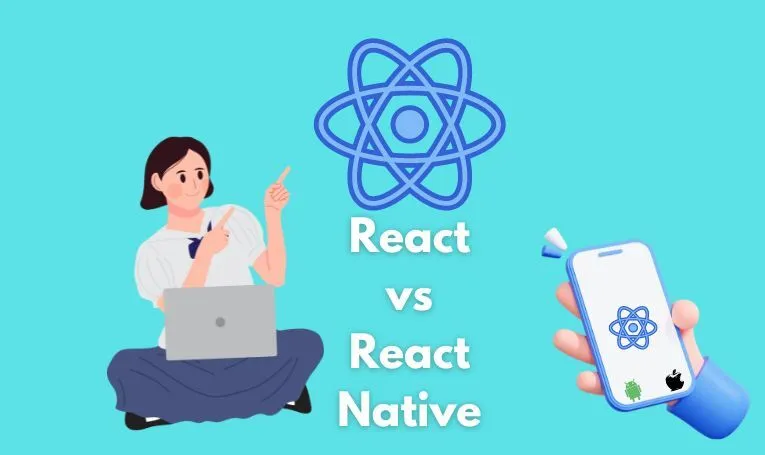- Address :Rampora, Qamarwari, Srinagar, Jammu and Kashmir 190010
- /
- Email : info@redstaglabs.com
- Home
- -Blog
React vs React Native: A Detailed Comparison of Capabilities and Performance

- Updated on 30 July2024
- Admin
React vs React Native: A Detailed Comparison of Capabilities and Performance
Introduction:
With mobile app development growing rapidly, developers often wonder whether to use React or React Native for building their mobile applications. Both JavaScript libraries were created by Facebook and share some similar capabilities, but they have key differences that impact what types of apps can be built and their performance.
React first released in 2013 focuses on building declarative web-based user interfaces that run on the browser. React Native, released just two years later in 2015, allows developers to build performant native mobile apps for iOS and Android using React architecture. According to Statista, global mobile app revenues in 2023 are forecasted to grow to $935 billion dollars. So choosing the right framework is an important decision.
The goal of this article is to provide a detailed yet easy-to-understand comparison of React vs React Native to help developers select the right framework based on their mobile app needs and capabilities required. We will analyze key metrics like speed, platform support, access to native features, code reuse ability, required skills and more through benchmarks, data examples and practical considerations. By the end, you should have a firm grasp on when React or React Native is more appropriate for your mobile project idea and capabilities you want built.
The comparison overview will enable any intermediate JavaScript developer looking to build mobile applications understand where React performs better and where React Native outshines based on the type of mobile user interfaces and interactions required. Let's dive in!
Background on React and React Native
React Overview and Capabilities

React is an open-source JavaScript library created by Facebook focused on building fast, interactive user interfaces for web applications. Some key capabilities and purposes of React include:
- Building encapsulated components that manage their own state
- Composing complex UIs from simple components
- Server-side rendering for improved performance
- Only updates components that need re-rendering for optimized DOM manipulation
- Integrates with other libraries and frameworks like React Router or Redux
React Native Overview and Capabilities

React Native is an open-source mobile app framework created by Facebook that allows developers to build native iOS and Android apps using React architecture. Some core capabilities include:
- Build truly native mobile applications for iOS and Android
- Use React framework to leverage JavaScript and React patterns
- Access device capabilities like camera, location services, etc. directly
- Near-native performance with multi-threading support
- Live reload to view changes instantly
- Reuse code across iOS, Android, and web apps
Key Similarities:
- Both React and React Native use a component-based architecture, allowing developers to build encapsulated components that manage their own state and compose them to create complex UIs.
- Both frameworks use JavaScript and JSX (JavaScript XML) to build user interfaces, making it easy for developers to switch between web and mobile development
- React and React Native share a large portion of the React ecosystem, including state management libraries like Redux, hooks, and context API, which can be used across both platforms
- The business logic written in JavaScript can be shared between React and React Native, which reduces duplication of code and speeds up development.
Key Differences:
While React and React Native share React architecture, there are some major differences:
- React is for web and React Native is for mobile app development
- React uses native browser rendering while React Native uses native mobile rendering
- React web components render using DOM whereas React Native uses native components
- Additional UI components and APIs available with React Native for mobile
- React Native allows accessing device hardware features unavailable to web apps
The fundamental difference is React Native uses the same React framework but compiles written JavaScript code into native views instead of web views as React does.
Performance Comparison
Performance is a key consideration when choosing a framework for mobile application development. Some key performance metrics we will compare include startup time, UI render speed, app size and limitations.
Metrics like Startup Time & Render Speed
According to Dev.to benchmarks, React Native has a slower cold start, taking 470 ms to become interactive compared to React's 170 ms. This is likely due to the JavaScript environment setup required by React Native. However, React Native has faster UI rendering speeds at 28-30 FPS versus React's 44 FPS.
For context, native mobile development using Java/Kotlin (Android) and Objective-C/Swift (iOS) score even faster for both startup time and UI rendering. But React Native is impressive given it uses JavaScript and still nears native performance.
App Size Considerations
In terms of app size, React Native also compares favorably to native app development. Example app sizes for medium complexity apps are:
- React Native: 18MB
- Native iOS App: 145MB
- Native Android App: 87MB
So React Native enables significantly lower app sizes than native while React web app sizes can vary dramatically depending on assets usage.
Performance Limitations
However, React Native does face some limitations for more complex graphic intensive apps. For example, React Native relies on a JavaScript thread and communication bridge which can cause lags for complex list views or animations. Games and 3D model apps still benefit from fully native development. React with web libraries like WebGL can build graphic rich apps unsupported by React Native.
Overall for most typical apps, React Native provides excellent startup time and smooth UI rendering that matches reasonably to fully native mobile development while providing size benefits. But graphic/animation intense apps see advantages choosing native or React web development.
Capability and Feature Comparison
What Interfaces and Capabilities Each Can Build
- React is best suited for building complex web application user interfaces. It can power highly interactive web apps like social networks, news sites, etc.
- React Native can build mobile applications with similar UI capabilities. Things like feed, messaging, stories interfaces translate well. But very graphics intensive apps can face limits.
Supported Platforms
- React supports all major web browsers like Chrome, Firefox, Safari, Edge, etc., enabling web app development. It can also render on mobile browsers though with limitations.
- React Native compiles to native iOS and Android apps. It requires different skills than web development and can leverage much of React patterns but adds mobile-centric capabilities.
Access to Native Device APIs
- React web apps have limited access to native hardware like camera, sensors, etc., due to browser security constraints. This often requires hacky workarounds.
- React Native provides direct native modules to tap into device capabilities like camera, location, push notifications, etc. It offers much more control compared to web apps.
Code Reuse Ability
- React promotes reusing UI components across web applications. HTML/CSS code can also be reused, but it's largely web-specific.
- A key advantage of React Native is being able to reuse JavaScript logic across iOS, Android, and even web apps. It follows a "write once, use everywhere" approach.
Community Support and Maturity
Size of Communities
- React has an enormous global community behind it as one of the most popular web frameworks. There are tons of examples, tutorials, and courses available.
- React Native community is smaller than React but still very active. Growth is rapid as companies adopt it for mobile. Resources may be less abundant than web React.
Available Libraries and Extensions
- React ecosystem provides thousands of high-quality libraries for animations, state management, APIs, etc. It's very extensible.
- React Native also has great libraries, but with a smaller set focused on mobile needs. React ecosystem libraries may be incompatible with React Native.
Development Roadmap and Future Support
- Facebook stands strongly behind advancing React for web interface needs. React will continue receiving updates for years, making it a safe long-term bet.
- Similarly, Facebook is invested in React Native to power mobile apps going forward. Rapid iteration so far indicates it will be supported and expanded for mobile development.
Both have strong backing for growth. But React as a more mature solution has longer track record so far. React Native direction very positive given Facebook dependence and community interest.
Conclusion:
React and React Native share core conceptual similarities but have key distinctions that dictate their ideal mobile app development use cases. React's strength is building complex browser-based web application interfaces with extensive community libraries for needs like state management and UI animations. It provides unmatched flexibility and interactivity for web experiences.
Meanwhile, React Native makes native mobile development accessible for web developers leveraging JavaScript and React patterns. It compiles performant iOS and Android app UIs capable of tapping into device hardware like camera and GPS more easily than web apps can access. Tradeoffs come in more limited community components and growing pains building highly complex animated interfaces.
Weighing their capabilities, React shines for apps deeply integrated into device features or requiring very intensive visual experiences like games. It unlocks native compilation and hardware APIs inaccessible from the browser constraints. On the other hand, React remains supreme for highly interactive web applications. Choices come down to whether native device access or browser-based experienced matter more.




